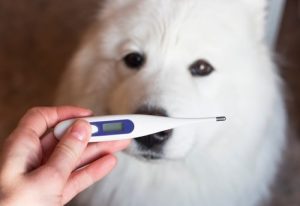A fever occurs when your dog’s body temperature is higher than normal. The normal body temperature for a healthy adult dog should be between 38 and 39.2 °C. A normal temperature for puppies is slightly lower than this, around 36-38℃, and increases in the first few weeks of life.
A fever, high temperature, or pyrexia in your dog can be due to many different causes. These can vary from something mild to something very serious. It can be dangerous if not treated promptly.
What to do
What to do if you think your dog has a fever
It’s important to get your dog checked by a vet as soon as possible. If left untreated, a fever can lead to serious side effects. These include swelling of the brain and blood clotting problems, which can be fatal.
The most common signs we see in dogs with a high temperature are:
- Lethargy (low energy)
- Hiding or reluctance to move
- Not wanting to eat or drink
- Shivering or stiffness
- Breathing faster than normal

We can see other symptoms depending on the cause of the fever, such as diarrhoea, vomiting, sneezing, coughing, and limping.
Our Joii team are available 24 hours a day, call us now if you have any questions.
Causes
Common causes of fevers in dogs
Most common causes
- Wounds or abscesses, such as tooth root abscesses or from a bite
- Infections such as kennel cough, Parvovirus, and urinary or womb infections
- Pancreatitis

Less Common
- Immune-mediated conditions: IMHA (immune-mediated haemolytic anaemia), IMPA (immune-mediated polyarthritis), IMTP (immune mediated-thrombocytopenia)
- Lyme Disease
- Parasites such as Toxoplasma or Leishmania
- Trauma causing Wounds
- Fungal infections
- Medications: vaccines and some types of antibiotics
These reactions should be mild and resolve on their own within 1-2 days.
- Poisons and toxins such as insecticides
- Cancers such as lymphosarcoma
Fever of unknown origin is a term used when a dog has a persistent fever without an immediately obvious cause.
It’s important to know that fever and heat stroke are different conditions.
- Heat stroke is when the body’s temperature rises suddenly and it is unable to cool itself quickly. This is often caused by a hot environment or physical activity.
Find out more about Heat stroke in dogs
When to worry
When to worry about a fever in your dog
A fever that has not resolved within 48 hours can be life-threatening!
Seek help from your local vet practice if
- Your dog is breathing faster than normal.
- Your dog has had any of these symptoms for over 24 hours: lethargy, not eating or drinking, shivering, or shaking.
Joii can help if
- Your dog has suddenly developed any of the symptoms mentioned, but it has been less than 24 hours.
- You’ve checked your dog’s temperature at home, and it’s above 39.2 °C.
- Your dog has recently had a vaccine and is unwell afterward.
- You have any questions about encouraging your dog with a fever to eat or drink.
Prevention
Tips on how to prevent your dog from developing a fever
- Keep your dog up to date with their vaccinations.
- Check your dog regularly for any wounds or swellings on its body.
- Keep your dog up to date with regular flea, tick, and worm preventative medication.
- Prevent access to any toxins, including human medications.
- Avoid sudden diet changes and access to fatty foods.
Diagnosis
How to know if your dog has a fever
If your dog shows any of the symptoms above, we recommend an exam with your local vet. They can check the temperature accurately.
Unfortunately, it is impossible to tell if your dog has a fever by feeling the ears, nose, or bare skin. These areas can feel warm even when there is no fever present.
- Ear thermometers can be used at home to check your dog’s temperature. These are not as accurate as rectal thermometers.
- Digital rectal thermometers are more accurate. We would only recommend this if you have previous experience under veterinary guidance. They can damage the rectal tissue if not used properly.

Home treatment
How can I help at home if my dog has a fever?
Once your dog has a fever and is on appropriate medication from your local veterinarian, you can help with recovery by
- Make sure there is fresh water available. This should be within easy reach in several areas of the house.
- Allow them to rest. Make sure there is a safe, quiet place to sleep.
- Encourage eating. Feed soft, bland food, such as boiled eggs or chicken. Add water to their food and heat it.
- Brush your dog regularly to avoid any mats forming.
Never give your dog any human medication, as this can be toxic!
Vet treatment
Vet treatment for fever in dogs
Your vet will examine the whole body to find any abnormalities that could be causing the fever. These may be wounds, lumps, or signs of trauma.
Some issues, such as a bite abscess, wound, or mild respiratory infection, might only need medication without any further tests.
If there is not an obvious cause on the initial exam, your veterinarian may suggest
- Blood tests to check the internal organs and red and white blood cells.
- Blood tests to check for infectious causes.
- Urine tests
- Blood cultures
- Imaging: such as x-rays, ultrasounds, CT scans, or MRIs.
Treatment depends on the underlying cause and may include
- Antibiotics
- Non-steroidal anti-inflammatory medications
- Steroids
- Hospitalisation for fluids and monitoring.
- Biopsy or surgery for any masses.
Risk
Are some dogs at greater risk of developing a fever?
A fever can affect all ages, breeds, and sexes of dogs.
Infectious causes are more common in
- Young dogs
- Dogs that have been abroad: Babesia, Leishmania, Ehrlichia, and Rabies
- Unvaccinated dogs
- Dogs that have increased exposure to ticks
Inflammatory causes are more common in:
- IMHA (immune-mediated haemolytic anaemia): Cocker Spaniels, English Springer Spaniels, Poodles, Irish Setters, Old English Sheepdogs
Neoplastic (cancer) causes are more common in:
- Older dogs
- Certain breeds, depending on the type of cancer
Do you want to know more about the specific causes of fever in dogs?
Viral (can all be prevented by vaccine)
- Kennel cough or Infectious Tracheobronchitis: Highly contagious airway disease with bacterial and viral parts. Symptoms include a hacking cough and lethargy, which can range from mild to severe.
- Parvovirus: Highly contagious and causes severe disease. It can often be fatal. Symptoms include bloody diarrhoea, vomiting, lethargy, and tummy pain. Younger dogs are most at risk.
- Infectious Hepatitis: A contagious liver disease caused by Adenovirus. It mostly affects young dogs. Symptoms tend to be vague – lethargy and not eating.
- Distemper: Highly contagious, often incurable, and fatal disease. Symptoms include diarrhoea, vomiting, and yellow discharge from the eyes and nose. Young dogs are most at risk.
- Rabies: Fatal disease that affects the brain and can spread to most mammals, including humans. The UK is rabies-free, but your pet may be at risk if they have been abroad. Usually spread through a bite or scratch from infected animals. Symptoms include behaviour changes, drooling, and difficulty walking.
Bacterial
- Leptospirosis: Can vaccinate against. Spread through urine, contaminated water, and soil. Causes liver and kidney damage and can often be fatal. Symptoms include yellow gums, limping, and weakness. Can spread to humans.
- Tooth Root Abscess: Severe infection around the root of the tooth, hidden under the gum. Treatment is often straightforward and successful. Symptoms include swelling below the eye, reluctance to chew, and bad breath.
- Campylobacter: Usually causes mild, watery diarrhoea. In younger dogs, it can be more severe. Usually spread from infected stools or contaminated meat and water. Can spread to humans.
- Ehrlichia: Spread by ticks; rare in the UK; usually carried in from abroad. Symptoms include reduced appetite and weight loss. Can be asymptomatic for months.
- Pyometra: This is when the womb develops an infection. It is an extremely serious disease in female dogs that are not neutered. The main symptoms include drinking more, peeing more, a discharge from the vulva, and lethargy. Surgery is usually required for treatment.
- Cystitis: Inflammation of the bladder. The main symptoms are usually blood in the urine and straining to pass small amounts of urine.
Parasites
- Toxoplasma: Young dogs and those with weak immune systems are most at risk. Symptoms include diarrhoea, weakness, and reduced appetite. The infection usually comes from infected soil, cat faeces, or meat.
- Babesia: Transmitted by ticks and causes damage to the red blood cells. Symptoms include weakness and pale or yellow gums. Common in Europe, not common in the UK.
- Leishmania: Severe disease that can cause skin lesions and sometimes kidney disease. Common in Europe, less so in the UK. It has been found in dogs that have never travelled, though this is rare.
Other
- Pancreatitis: Common symptoms include vomiting, diarrhoea, tummy pain, and reduced appetite. Can range from mild to severe and is often, though not always, linked to a fatty meal.
- Lyme Disease: Spread by ticks. Symptoms include limping, lethargy, and loss of appetite. Treatment is effective if caught early.
- IMHA and IMTP (Immune-mediated haemolytic anaemia and thrombocytopenia): Diseases in which the immune system attacks its red blood cells (HA) and platelets (TP). Life-threatening disease. The main symptoms include not eating, pale or yellow gums, and lethargy.
- IMPA (Immune-mediated polyarthritis): Disease in which the immune system attacks the joints. Symptoms include limping, swollen joints, and reluctance to move.
- SRMA (Steroid responsive meningitis arteritis): Auto-immune disease affecting the nervous system. More common in young dogs. Symptoms include severe neck pain, a reluctance to move, and eating less.
- SLE (Systemic Lupus Erythematosus): Auto-immune disease that can be fatal. Can affect many organs in the body. Common symptoms include skin lesions, limping, reduced appetite, and lethargy.








